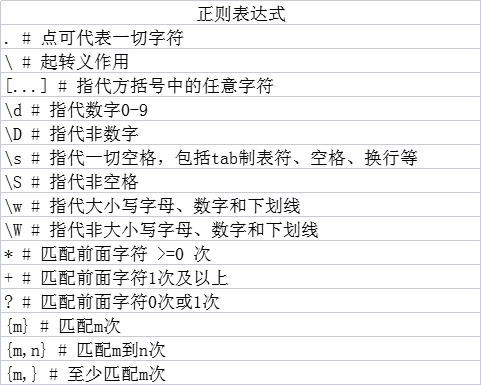正则 re.findall 的简单用法(返回string中所有与pattern相匹配的全部字串,返回形式为数组)
语法:findall(pattern, string, flags=0)
第一个参数,正则表达式
第二个参数,搜索的是那些字符串
第三个参数,匹配的模式,其中re.S使匹配包括换行在内的所有字符。findall()函数是逐行匹配的。
一、正则表达式的含义

懒惰匹配与贪婪匹配。
表达式 .* 的意思很好理解,就是单个字符匹配任意次,即贪婪匹配。
表达式 .*? 是满足条件的情况只匹配一次,即懒惰匹配
var str = 'Anna is {age} years old,Bob is {age} years old too';
var expr = /{.*?}/g;
console.log(str.replace(expr, '13'));
命令行输出: Anna is 13 years old,Bob is 13 years old too
可以看出,懒惰模式下,只要满足条件,就不再向后匹配,以下是贪婪模式:
var str = 'Anna is {age} years old,Bob is {age} years old too';
var expr = /{.*}/g;
console.log(str.replace(expr, '13'));
命令行输出: Anna is 13 years old too
返回string中所有与pattern相匹配的全部字串,返回形式为数组
符号^表示匹配以https开头的的字符串返回, regular_v2 = re.findall(r"^https","https://docs.python.org/3/whatsnew/3.6.html") print (regular_v2) # ['https'] 用$符号表示以html结尾的字符串返回,判断是否字符串结束的字符串 regular_v3 = re.findall(r"html$","https://docs.python.org/3/whatsnew/3.6.html") print (regular_v3) # ['html']
# [...]匹配括号中的其中一个字符 regular_v4 = re.findall(r"[t,w]h","https://docs.python.org/3/whatsnew/3.6.html") print (regular_v4) # ['th', 'wh']
“d”是正则语法规则用来匹配0到9之间的数返回列表 regular_v5 = re.findall(r"\d","https://docs.python.org/3/whatsnew/3.6.html") regular_v6 = re.findall(r"\d\d\d","https://docs.python.org/3/whatsnew/3.6.html/1234") print (regular_v5) # ['3', '3', '6'] print (regular_v6) # ['123'] 小d表示取数字0-9,大D表示不要数字,也就是出了数字以外的内容返回 regular_v7 = re.findall(r"\D","https://docs.python.org/3/whatsnew/3.6.html") print (regular_v7) # ['h', 't', 't', 'p', 's', ':', '/', '/', 'd', 'o', 'c', 's', '.', 'p', 'y', 't', 'h', 'o', 'n', '.', 'o', 'r', 'g', '/', '/', 'w', 'h', 'a', 't', 's', 'n', 'e', 'w', '/', '.',
'.', 'h', 't', 'm', 'l']
“w”在正则里面代表匹配从小写a到z,大写A到Z,数字0到9 regular_v8 = re.findall(r"\w","https://docs.python.org/3/whatsnew/3.6.html") print (regular_v8) #['h', 't', 't', 'p', 's', 'd', 'o', 'c', 's', 'p', 'y', 't', 'h', 'o', 'n', 'o', 'r', 'g', '3', 'w', 'h', 'a', 't', 's', 'n', 'e', 'w', '3', '6', 'h', 't', 'm', 'l'] “W”在正则里面代表匹配除了字母与数字以外的特殊符号 regular_v9 = re.findall(r"\W","https://docs.python.org/3/whatsnew/3.6.html") print (regular_v9) # [':', '/', '/', '.', '.', '/', '/', '/', '.', '.']